Table of Contents
Easy Banana Bread Recipe With Self Rising Flour
Baking a moist and flavorful banana bread is now easier than ever with self rising flour. This recipe lets you skip the step of measuring out baking soda, baking powder, and salt. The self rising flour has it all mixed for you.
The result is a soft, tender, and subtly sweet banana bread. It’s easy to make. Whether you’re new to baking or have lots of experience, this method makes it simple to enjoy fresh-baked banana bread.
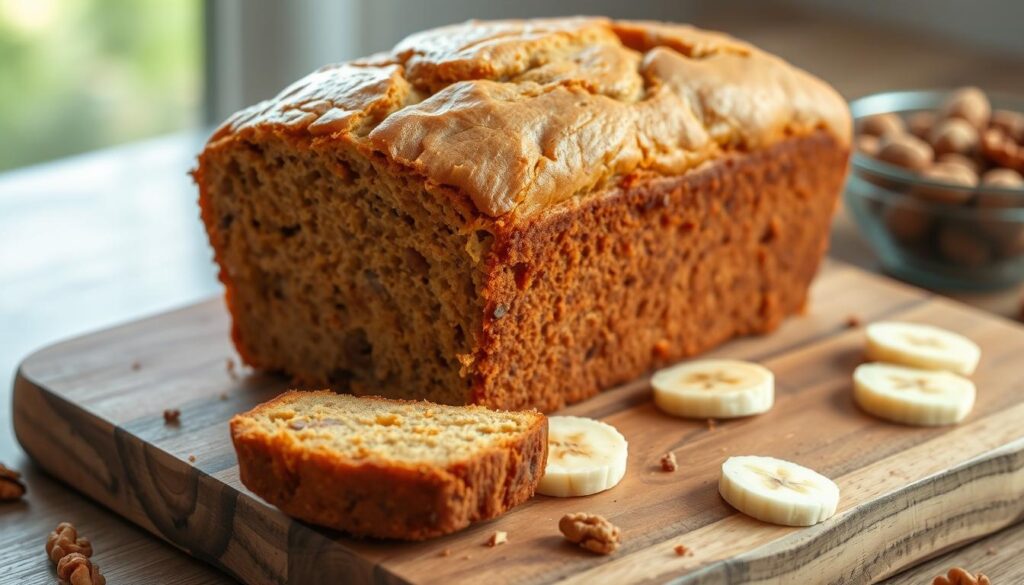
Key Takeaways
- Self rising flour simplifies banana bread baking by eliminating the need for separate leavening agents
- This recipe produces a moist, tender, and flavorful banana bread with minimal effort
- Using self rising flour saves time and reduces the chances of under or over-leavening the batter
- The end result is a delicious banana bread that’s perfect for breakfast, snacks, or dessert
- This easy method is ideal for both novice and experienced bakers
Why Self Rising Flour Makes Banana Bread Baking Easier
Baking banana bread is easier with self rising flour. This flour has the leavening agents mixed in. You don’t need to add baking soda or baking powder separately.
Understanding Self Rising Flour Composition
Self rising flour is a mix of all-purpose flour, baking powder, and a bit of salt. The baking powder makes the dough rise. This makes the bread light and fluffy. It’s perfect for quick breads like banana bread recipe using self rising flour.
Benefits of Using Self Rising Flour in Quick Breads
- Simplifies the recipe by reducing the number of ingredients needed
- Ensures even rise and consistent texture throughout the loaf
- Eliminates the guesswork of measuring and combining separate leavening agents
- Allows for faster, more efficient baking process
Choosing self raising flour banana bread makes baking easier. It’s quick and delicious. You can focus on other flavors and textures that make banana bread special.
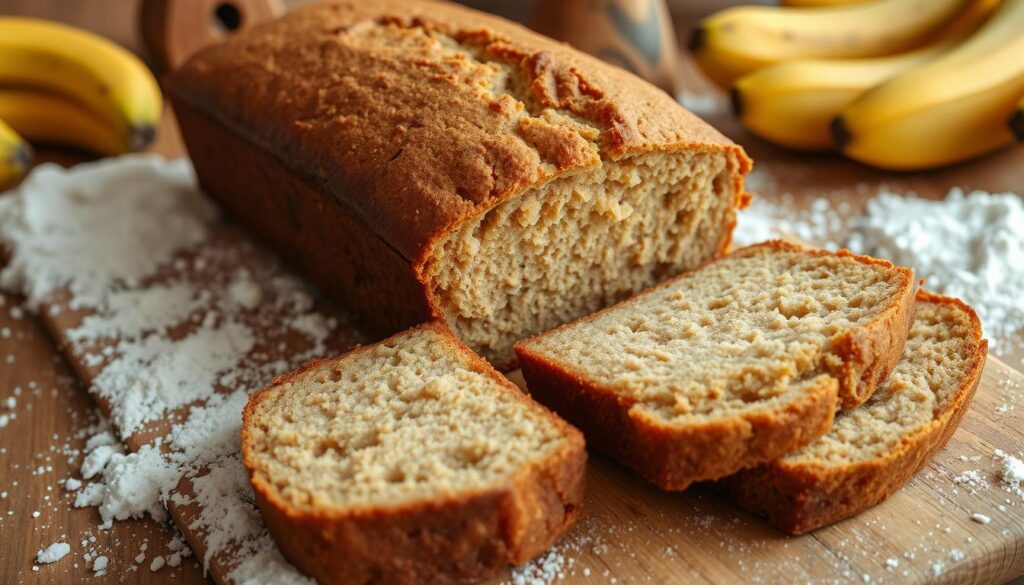
Essential Ingredients for Your Self Rising Flour Banana Bread
Baking banana bread is easy with self rising flour. This ingredient replaces baking soda, making the recipe simpler. It also helps your loaf rise beautifully. Let’s look at what you need for a moist and tasty banana bread recipe without baking soda, using self raising flour banana bread.
Ripe bananas are the base of this recipe. Choose bananas that are sweet and soft, with a few brown spots. These bananas add natural sweetness and moisture to your bread.
Self rising flour is the next key ingredient. It’s a mix of all-purpose flour, baking powder, and salt. This blend makes your banana bread recipe without baking soda rise easily.
Eggs and a bit of sugar are also important. Eggs help the bread hold together, and sugar balances the banana’s sweetness. Adding vanilla extract can enhance the flavor even more.
With these ingredients, you’re ready to bake a self raising flour banana bread that everyone will love. Now, let’s see what kitchen tools and equipment you’ll need to make it.
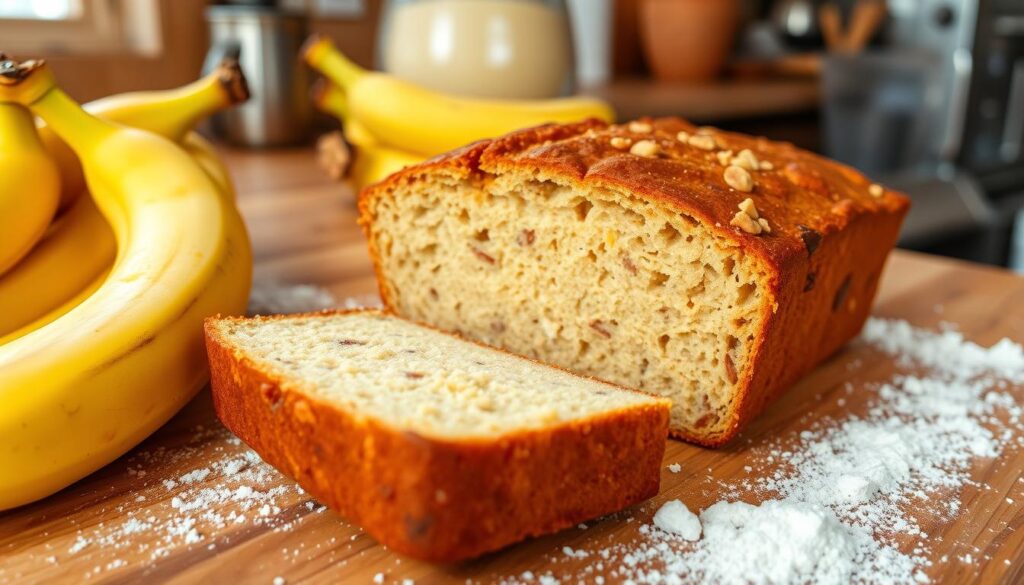
Kitchen Tools and Equipment Needed
Baking homemade banana bread using self raising flour needs some key tools. These tools help make sure your baking goes smoothly and tastes great. Whether you’re experienced or new to baking, the right tools are crucial for perfect banana bread.
Must-Have Baking Tools
- A large mixing bowl to combine the wet and dry ingredients
- A hand mixer or stand mixer for efficiently mixing the batter
- A loaf pan, preferably a 9×5-inch size, to bake the banana bread
- A wire rack for cooling the bread after it’s done baking
- A sharp knife or bread knife for slicing the cooled banana bread
Optional Equipment for Better Results
While the basic tools are essential, some extra equipment can make your banana bread even better. Here are some options:
- A muffin tin or mini loaf pans for making individual servings
- A food processor or high-powered blender to puree the bananas for a smoother batter
- A kitchen scale to accurately measure the ingredients, especially the flour
- A pastry brush to coat the loaf pan with butter or non-stick spray
- Parchment paper or a silicone baking mat to line the loaf pan for easy removal
With these tools, you’ll be ready to make a delicious banana bread using self raising flour. It will surely impress your loved ones.
How to Choose and Prepare Perfect Bananas
Choosing the right bananas is key when baking banana bread with self-rising flour. The ripeness of the fruit greatly affects the taste and texture of your banana bread. Let’s look at how to pick and prepare the best bananas for your recipe.
Choosing the Right Bananas
For a moist and tasty banana bread, use ripe bananas. Look for bananas with a yellow skin that has brown speckles. Stay away from green or fully brown bananas, as they might not be sweet enough or soft enough for your recipe.
The best bananas are just a bit past their prime. They should have a soft flesh and a deep yellow color.
Preparing Bananas for Baking
- Peel the bananas and place them in a bowl or on a cutting board.
- Using a fork or a potato masher, mash the bananas until they are smooth and free of lumps. This step helps ensure a uniform texture in your banana bread.
- If your recipe calls for a specific amount of mashed bananas, measure the quantity carefully to ensure the right balance of ingredients.
The riper the bananas, the stronger the flavor in your banana bread. Even overripe bananas with brown or black skins can add a deeper banana taste.
By following these tips for selecting and preparing the perfect bananas, you’ll be well on your way to creating a moist, flavorful, and delightful banana bread using self-rising flour.
Step-by-Step Banana Bread Recipe With Self Rising Flour
Making banana bread with self rising flour is easy. You don’t need to mix baking soda, baking powder, and salt. Self rising flour makes the process simple. Here’s how to make your own banana bread recipe without baking soda.
Mixing the Wet Ingredients
Start by mashing ripe bananas in a big bowl until smooth. Add room temperature eggs, melted butter or oil, and your favorite sweetener like brown sugar or honey. Mix until everything is well combined.
Incorporating Dry Ingredients
- Measure out the self raising flour and gently fold it into the wet ingredients. Be careful not to overmix.
- You can add mix-ins like chopped nuts, chocolate chips, or cinnamon if you want.
- Just stir the batter until it’s combined without overworking it.
Proper Baking Techniques
- Preheat your oven to 350°F (175°C) and grease a loaf pan.
- Pour the batter into the pan and smooth the top with a spatula.
- Bake the banana bread with self rising flour for 55-65 minutes. A toothpick should come out clean.
- Allow the loaf to cool in the pan for 10 minutes, then transfer it to a wire rack to cool completely.
By following these steps, you can make a moist, tasty banana bread recipe without baking soda using self rising flour. Enjoy your homemade treat and the amazing smell it brings to your kitchen!
Tips for Achieving the Perfect Texture
Baking the perfect banana bread using self raising flour means getting the texture just right. You want it soft and moist inside, with a golden-brown crust. Every part of the bread’s texture is important for a great taste. Here are some tips to help you get it right every time.
Using self raising flour in your banana bread makes it light and airy. The flour’s leavening agents make it tender and fluffy. But, to get the best results, mix the batter gently.
- Avoid over-mixing the batter: Overmixing can make the bread dense and tough. Mix the dry ingredients gently until they’re just combined. This helps avoid overworking the gluten.
- Use room-temperature ingredients: Make sure your eggs, butter, and bananas are at room temperature before mixing. This helps create a smooth batter that bakes well.
- Adjust baking time and temperature: Watch your banana bread while it bakes. You might need to change the oven temperature or baking time. A golden crust and a clean toothpick are signs it’s done.
By following these tips, you’ll make a moist, tender, and delicious banana bread using self raising flour. You’ll enjoy a perfectly baked loaf that will impress everyone.
Common Mistakes to Avoid When Using Self Rising Flour
Using self-rising flour simplifies the process of making banana bread. But, it has its own challenges. To get your banana bread recipe using self rising flour just right, avoid these common mistakes.
Temperature Considerations
Temperature is key when using self rising flour. It’s more sensitive to heat than all-purpose flour. So, don’t overbake. Watch the oven temperature and check your banana bread’s doneness to avoid dryness or toughness.
Mixing and Measuring Issues
Measuring self rising flour accurately is crucial. The leavening agents can be easily upset. Make sure to measure the flour exactly as the recipe says. Don’t overmix the batter, as it can make the bread dense and tough. Mix the ingredients gently for the best texture.
By avoiding these common mistakes, you can enjoy a delicious banana bread recipe using self rising flour. It’s convenient and doesn’t sacrifice taste or texture.
Creative Add-ins and Variations
Baking the perfect self raising flour banana bread opens up a world of possibilities. You can try different add-ins and variations to make it your own. This lets you customize the taste to your liking.
Adding nuts to your self raising flour banana bread is a great idea. Chopped walnuts, pecans, or toasted almonds bring a nice crunch and nutty flavor. For a warm, cozy taste, mix in a teaspoon of ground cinnamon or nutmeg.
If you love sweet treats, chocolate chips or chopped dark chocolate are perfect. They add a rich, sweet flavor that goes well with bananas. You can also try dried fruits like cranberries, raisins, or apricots for extra sweetness and texture.
| Add-in | Quantity | Flavor Profile |
|---|---|---|
| Chopped walnuts | 1/2 cup | Nutty, crunchy |
| Ground cinnamon | 1 teaspoon | Warm, spicy |
| Chocolate chips | 1 cup | Rich, decadent |
| Dried cranberries | 3/4 cup | Tart, chewy |
When adding ingredients, remember to adjust the baking time and temperature. This is because extra ingredients can change how the bread cooks. So, have fun and find your own special self raising flour banana bread recipe.
Storage Tips and Shelf Life
After making your banana bread with self rising flour, keeping it fresh is important. The right storage can make your treat last longer.
Freezing Guidelines
Banana bread freezes well, perfect for meal prep or pantry storage. Wrap the cooled loaf in plastic wrap or foil, then in a freezer bag. This way, your banana bread can stay fresh in the freezer for up to 3 months.
Reheating Methods
Ready to enjoy your frozen banana bread? There are easy ways to reheat it. Thaw the loaf in the fridge overnight, then slice and reheat in the oven at 350°F for 5-10 minutes. You can also toast or microwave frozen slices for a quick warm-up.
| Storage Method | Shelf Life |
|---|---|
| Room Temperature | 2-3 days |
| Refrigerator | 5-7 days |
| Freezer | Up to 3 months |
Follow these tips for storing and reheating your banana bread. You can enjoy it for days or even weeks. With the right care, your banana bread will stay moist and flavorful.
Troubleshooting Your Banana Bread
Baking banana bread with self rising flour can be a delightful experience. But sometimes, you might run into a few hiccups. Don’t worry! We’re here to help you troubleshoot and get your banana bread baking smoothly again.
One common issue is a sunken or uneven bake. This might happen if you over-mix the batter. Over-mixing can make the gluten in the flour develop too much. This can result in a dense and heavy loaf. To avoid this, gently fold in the dry ingredients until just combined. Avoid aggressive stirring.
If your banana bread turns out dry or crumbly, it could be due to using bananas that are not ripe enough. The best bananas for this recipe are ripe with some brown speckles. They provide the perfect balance of sweetness and moisture. Also, be careful with your baking time and temperature. An oven that’s too hot or a loaf that’s overbaked can make it dry.
FAQ
What makes self rising flour a great choice for banana bread?
Self rising flour has a built-in leavening agent. This means you don’t need to add baking soda or baking powder. It makes baking banana bread easier because you don’t have to mix and measure different ingredients.
What are the essential ingredients for making banana bread with self rising flour?
You’ll need self rising flour, ripe bananas, eggs, sugar, and butter or oil. You can also add nuts or chocolate chips for extra flavor. The self rising flour takes care of the leavening, so you can skip the baking soda.
What kitchen tools are needed for this banana bread recipe?
You’ll need a mixing bowl, whisk, spatula, loaf pan, and an oven. A stand mixer or hand mixer can help. A kitchen scale is also useful for measuring ingredients accurately.
How do I choose and prepare the perfect bananas for banana bread?
Choose bananas with brown speckles on the peel. They should be ripe. Avoid green or yellow bananas. Mash the bananas well before adding them to the batter.
What are the key steps in making banana bread with self rising flour?
Mix the wet ingredients first. Then, gently add the self rising flour until just combined. Don’t overmix. Bake at the right temperature and time for the best results.
How can I ensure my banana bread has the perfect texture?
Pay attention to mixing, baking time, and oven temperature. Avoid overmixing and bake until a toothpick comes out clean.
What common mistakes should I avoid when using self rising flour for banana bread?
Don’t use too much self rising flour. Adjust baking time and temperature correctly. And avoid overmixing. Accurate measurements and proper technique are key.
Can I add any additional ingredients to my banana bread recipe?
Yes! Self rising flour banana bread is perfect for add-ins. Try nuts, chocolate chips, cinnamon, or cream cheese swirls for extra flavor and texture.
How should I store and reheat my homemade banana bread?
Store banana bread in an airtight container at room temperature for up to 4 days. Freeze slices for longer storage. Reheat in the microwave or oven until warm.
What should I do if my banana bread doesn’t turn out as expected?
If your banana bread has issues like sinking or dryness, check your oven temperature, mixing, and banana ripeness. Make adjustments and try again for better results.Easy Banana Bread Recipe With Self Rising Flour
Baking a moist and flavorful banana bread is now easier than ever with self rising flour. This recipe lets you skip the step of measuring out baking soda, baking powder, and salt. The self rising flour has it all mixed for you.
The result is a soft, tender, and subtly sweet banana bread. It’s easy to make. Whether you’re new to baking or have lots of experience, this method makes it simple to enjoy fresh-baked banana bread.
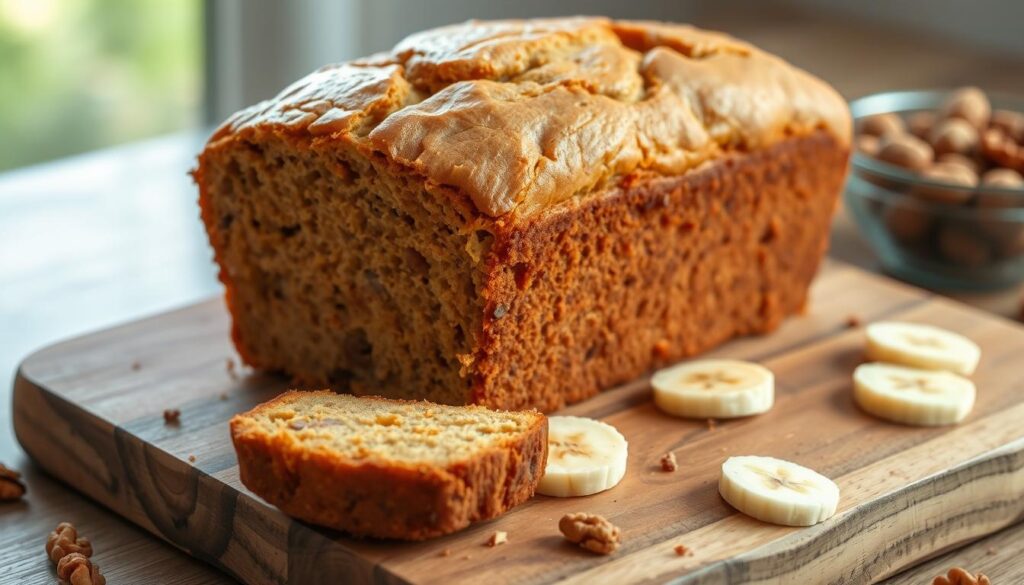
Key Takeaways
- Self rising flour simplifies banana bread baking by eliminating the need for separate leavening agents
- This recipe produces a moist, tender, and flavorful banana bread with minimal effort
- Using self rising flour saves time and reduces the chances of under or over-leavening the batter
- The end result is a delicious banana bread that’s perfect for breakfast, snacks, or dessert
- This easy method is ideal for both novice and experienced bakers
Why Self Rising Flour Makes Banana Bread Baking Easier
Baking banana bread is easier with self rising flour. This flour has the leavening agents mixed in. You don’t need to add baking soda or baking powder separately.
Understanding Self Rising Flour Composition
Self rising flour is a mix of all-purpose flour, baking powder, and a bit of salt. The baking powder makes the dough rise. This makes the bread light and fluffy. It’s perfect for quick breads like banana bread recipe using self rising flour.
Benefits of Using Self Rising Flour in Quick Breads
- Simplifies the recipe by reducing the number of ingredients needed
- Ensures even rise and consistent texture throughout the loaf
- Eliminates the guesswork of measuring and combining separate leavening agents
- Allows for faster, more efficient baking process
Choosing self raising flour banana bread makes baking easier. It’s quick and delicious. You can focus on other flavors and textures that make banana bread special.
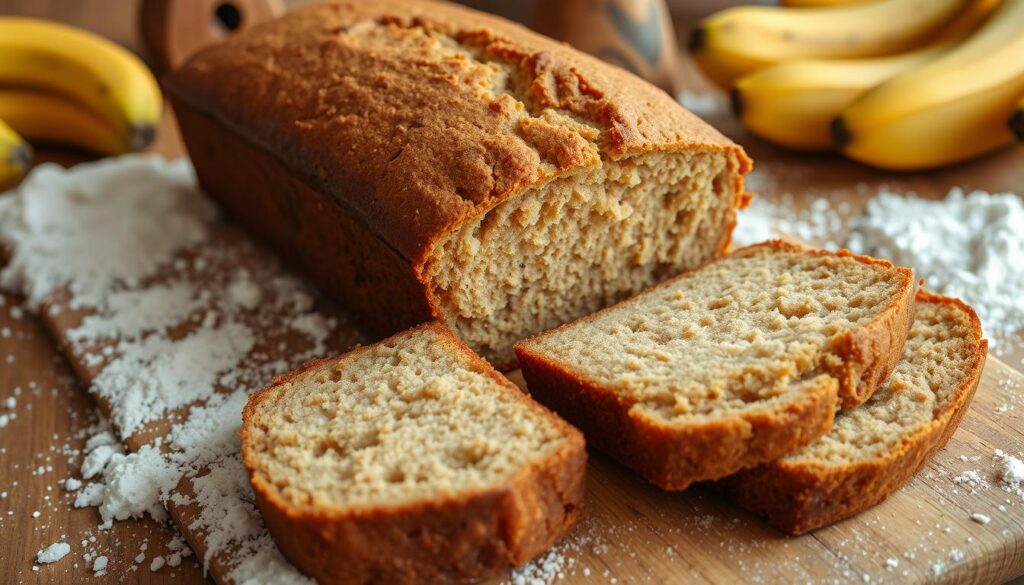
Essential Ingredients for Your Self Rising Flour Banana Bread
Baking banana bread is easy with self rising flour. This ingredient replaces baking soda, making the recipe simpler. It also helps your loaf rise beautifully. Let’s look at what you need for a moist and tasty banana bread recipe without baking soda, using self raising flour banana bread.
Ripe bananas are the base of this recipe. Choose bananas that are sweet and soft, with a few brown spots. These bananas add natural sweetness and moisture to your bread.
Self rising flour is the next key ingredient. It’s a mix of all-purpose flour, baking powder, and salt. This blend makes your banana bread recipe without baking soda rise easily.
Eggs and a bit of sugar are also important. Eggs help the bread hold together, and sugar balances the banana’s sweetness. Adding vanilla extract can enhance the flavor even more.
With these ingredients, you’re ready to bake a self raising flour banana bread that everyone will love. Now, let’s see what kitchen tools and equipment you’ll need to make it.
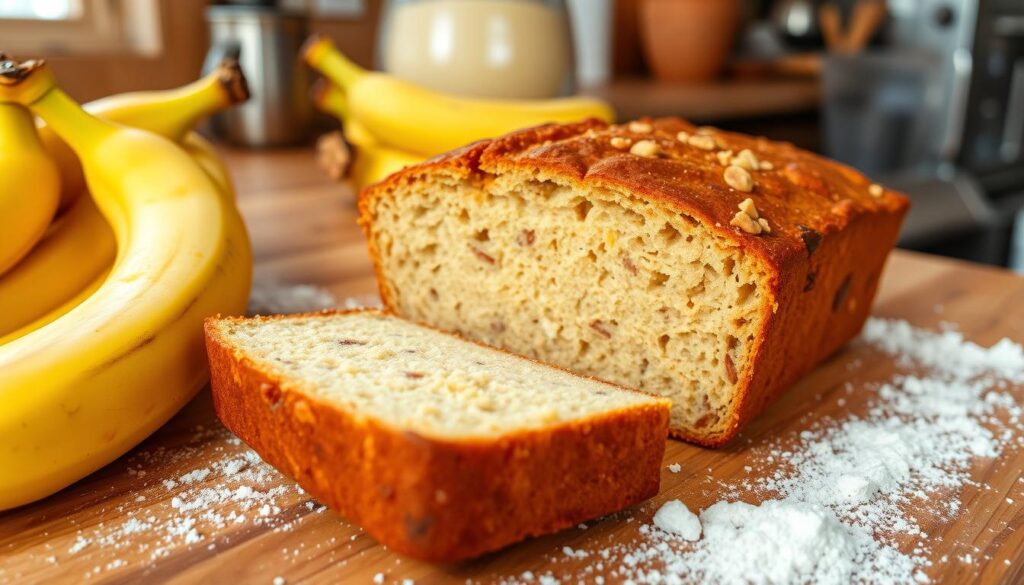
Kitchen Tools and Equipment Needed
Baking homemade banana bread using self raising flour needs some key tools. These tools help make sure your baking goes smoothly and tastes great. Whether you’re experienced or new to baking, the right tools are crucial for perfect banana bread.
Must-Have Baking Tools
- A large mixing bowl to combine the wet and dry ingredients
- A hand mixer or stand mixer for efficiently mixing the batter
- A loaf pan, preferably a 9×5-inch size, to bake the banana bread
- A wire rack for cooling the bread after it’s done baking
- A sharp knife or bread knife for slicing the cooled banana bread
Optional Equipment for Better Results
While the basic tools are essential, some extra equipment can make your banana bread even better. Here are some options:
- A muffin tin or mini loaf pans for making individual servings
- A food processor or high-powered blender to puree the bananas for a smoother batter
- A kitchen scale to accurately measure the ingredients, especially the flour
- A pastry brush to coat the loaf pan with butter or non-stick spray
- Parchment paper or a silicone baking mat to line the loaf pan for easy removal
With these tools, you’ll be ready to make a delicious banana bread using self raising flour. It will surely impress your loved ones.
How to Choose and Prepare Perfect Bananas
Choosing the right bananas is key when baking banana bread with self-rising flour. The ripeness of the fruit greatly affects the taste and texture of your banana bread. Let’s look at how to pick and prepare the best bananas for your recipe.
Choosing the Right Bananas
For a moist and tasty banana bread, use ripe bananas. Look for bananas with a yellow skin that has brown speckles. Stay away from green or fully brown bananas, as they might not be sweet enough or soft enough for your recipe.
The best bananas are just a bit past their prime. They should have a soft flesh and a deep yellow color.
Preparing Bananas for Baking
- Peel the bananas and place them in a bowl or on a cutting board.
- Using a fork or a potato masher, mash the bananas until they are smooth and free of lumps. This step helps ensure a uniform texture in your banana bread.
- If your recipe calls for a specific amount of mashed bananas, measure the quantity carefully to ensure the right balance of ingredients.
The riper the bananas, the stronger the flavor in your banana bread. Even overripe bananas with brown or black skins can add a deeper banana taste.
By following these tips for selecting and preparing the perfect bananas, you’ll be well on your way to creating a moist, flavorful, and delightful banana bread using self-rising flour.
Step-by-Step Banana Bread Recipe With Self Rising Flour
Making banana bread with self rising flour is easy. You don’t need to mix baking soda, baking powder, and salt. Self rising flour makes the process simple. Here’s how to make your own banana bread recipe without baking soda.
Mixing the Wet Ingredients
Start by mashing ripe bananas in a big bowl until smooth. Add room temperature eggs, melted butter or oil, and your favorite sweetener like brown sugar or honey. Mix until everything is well combined.
Incorporating Dry Ingredients
- Measure out the self raising flour and gently fold it into the wet ingredients. Be careful not to overmix.
- You can add mix-ins like chopped nuts, chocolate chips, or cinnamon if you want.
- Just stir the batter until it’s combined without overworking it.
Proper Baking Techniques
- Preheat your oven to 350°F (175°C) and grease a loaf pan.
- Pour the batter into the pan and smooth the top with a spatula.
- Bake the banana bread with self rising flour for 55-65 minutes. A toothpick should come out clean.
- Let the loaf cool in the pan for 10 minutes before cooling it on a wire rack.
By following these steps, you can make a moist, tasty banana bread recipe without baking soda using self rising flour. Enjoy your homemade treat and the amazing smell it brings to your kitchen!
Tips for Achieving the Perfect Texture
Baking the perfect banana bread using self raising flour means getting the texture just right. You want it soft and moist inside, with a golden-brown crust. Every part of the bread’s texture is important for a great taste. Here are some tips to help you get it right every time.
Using self raising flour in your banana bread makes it light and airy. The flour’s leavening agents make it tender and fluffy. But, to get the best results, mix the batter gently.
- Avoid over-mixing the batter: Overmixing can make the bread dense and tough. Mix the dry ingredients gently until they’re just combined. This helps avoid overworking the gluten.
- Use room-temperature ingredients: Make sure your eggs, butter, and bananas are at room temperature before mixing. This helps create a smooth batter that bakes well.
- Adjust baking time and temperature: Watch your banana bread while it bakes. You might need to change the oven temperature or baking time. A golden crust and a clean toothpick are signs it’s done.
By following these tips, you’ll make a moist, tender, and delicious banana bread using self raising flour. You’ll enjoy a perfectly baked loaf that will impress everyone.
Common Mistakes to Avoid When Using Self Rising Flour
Baking with self rising flour makes banana bread easy to make. But, it has its own challenges. To get your banana bread recipe using self rising flour just right, avoid these common mistakes.
Temperature Considerations
Temperature is key when using self rising flour. It’s more sensitive to heat than all-purpose flour. So, don’t overbake. Watch the oven temperature and check your banana bread’s doneness to avoid dryness or toughness.
Mixing and Measuring Issues
Measuring self rising flour accurately is crucial. The leavening agents can be easily upset. Make sure to measure the flour exactly as the recipe says. Don’t overmix the batter, as it can make the bread dense and tough. Mix the ingredients gently for the best texture.
By avoiding these common mistakes, you can enjoy a delicious banana bread recipe using self rising flour. It’s convenient and doesn’t sacrifice taste or texture.
Creative Add-ins and Variations
Baking the perfect self raising flour banana bread opens up a world of possibilities. You can try different add-ins and variations to make it your own. This lets you customize the taste to your liking.
Adding nuts to your self raising flour banana bread is a great idea. Chopped walnuts, pecans, or toasted almonds bring a nice crunch and nutty flavor. For a warm, cozy taste, mix in a teaspoon of ground cinnamon or nutmeg.
If you love sweet treats, chocolate chips or chopped dark chocolate are perfect. They add a rich, sweet flavor that goes well with bananas. You can also try dried fruits like cranberries, raisins, or apricots for extra sweetness and texture.
| Add-in | Quantity | Flavor Profile |
|---|---|---|
| Chopped walnuts | 1/2 cup | Nutty, crunchy |
| Ground cinnamon | 1 teaspoon | Warm, spicy |
| Chocolate chips | 1 cup | Rich, decadent |
| Dried cranberries | 3/4 cup | Tart, chewy |
When adding ingredients, remember to adjust the baking time and temperature. This is because extra ingredients can change how the bread cooks. So, have fun and find your own special self raising flour banana bread recipe.
Storage Tips and Shelf Life
After making your banana bread with self rising flour, keeping it fresh is important. The right storage can make your treat last longer.
Freezing Guidelines
Banana bread freezes well, perfect for meal prep or pantry storage. Wrap the cooled loaf in plastic wrap or foil, then in a freezer bag. This way, your banana bread can stay fresh in the freezer for up to 3 months.
Reheating Methods
Ready to enjoy your frozen banana bread? There are easy ways to reheat it. Thaw the loaf in the fridge overnight, then slice and reheat in the oven at 350°F for 5-10 minutes. You can also toast or microwave frozen slices for a quick warm-up.
| Storage Method | Shelf Life |
|---|---|
| Room Temperature | 2-3 days |
| Refrigerator | 5-7 days |
| Freezer | Up to 3 months |
Follow these tips for storing and reheating your banana bread. You can enjoy it for days or even weeks. With the right care, your banana bread will stay moist and flavorful.
Troubleshooting Your Banana Bread
Baking banana bread with self rising flour can be a delightful experience. But sometimes, you might run into a few hiccups. Don’t worry! We’re here to help you troubleshoot and get your banana bread baking smoothly again.
One common issue is a sunken or uneven bake. This might happen if you over-mix the batter. Over-mixing can make the gluten in the flour develop too much. This can result in a dense and heavy loaf. To avoid this, gently fold in the dry ingredients until just combined. Avoid aggressive stirring.
If your banana bread turns out dry or crumbly, it could be due to using bananas that are not ripe enough. The best bananas for this recipe are ripe with some brown speckles. They provide the perfect balance of sweetness and moisture. Also, be careful with your baking time and temperature. An oven that’s too hot or a loaf that’s overbaked can make it dry.
FAQ
What makes self rising flour a great choice for banana bread?
Self rising flour has a built-in leavening agent. This means you don’t need to add baking soda or baking powder. It makes baking banana bread easier because you don’t have to mix and measure different ingredients.
What are the essential ingredients for making banana bread with self rising flour?
You’ll need self rising flour, ripe bananas, eggs, sugar, and butter or oil. You can also add nuts or chocolate chips for extra flavor. The self rising flour takes care of the leavening, so you can skip the baking soda.
What kitchen tools are needed for this banana bread recipe?
You’ll need a mixing bowl, whisk, spatula, loaf pan, and an oven. A stand mixer or hand mixer can help. A kitchen scale is also useful for measuring ingredients accurately.
How do I choose and prepare the perfect bananas for banana bread?
Choose bananas with brown speckles on the peel. They should be ripe. Avoid green or yellow bananas. Mash the bananas well before adding them to the batter.
What are the key steps in making banana bread with self rising flour?
Mix the wet ingredients first. Then, gently add the self rising flour until just combined. Don’t overmix. Bake at the right temperature and time for the best results.
How can I ensure my banana bread has the perfect texture?
Pay attention to mixing, baking time, and oven temperature. Avoid overmixing and bake until a toothpick comes out clean.
What common mistakes should I avoid when using self rising flour for banana bread?
Don’t use too much self rising flour. Adjust baking time and temperature correctly. And avoid overmixing. Accurate measurements and proper technique are key.
Can I add any additional ingredients to my banana bread recipe?
Yes! Self rising flour banana bread is perfect for add-ins. Try nuts, chocolate chips, cinnamon, or cream cheese swirls for extra flavor and texture.
How should I store and reheat my homemade banana bread?
Store banana bread in an airtight container at room temperature for up to 4 days. Freeze slices for longer storage. Reheat in the microwave or oven until warm.
What should I do if my banana bread doesn’t turn out as expected?
If your banana bread has issues like sinking or dryness, check your oven temperature, mixing, and banana ripeness. Make adjustments and try again for better results.

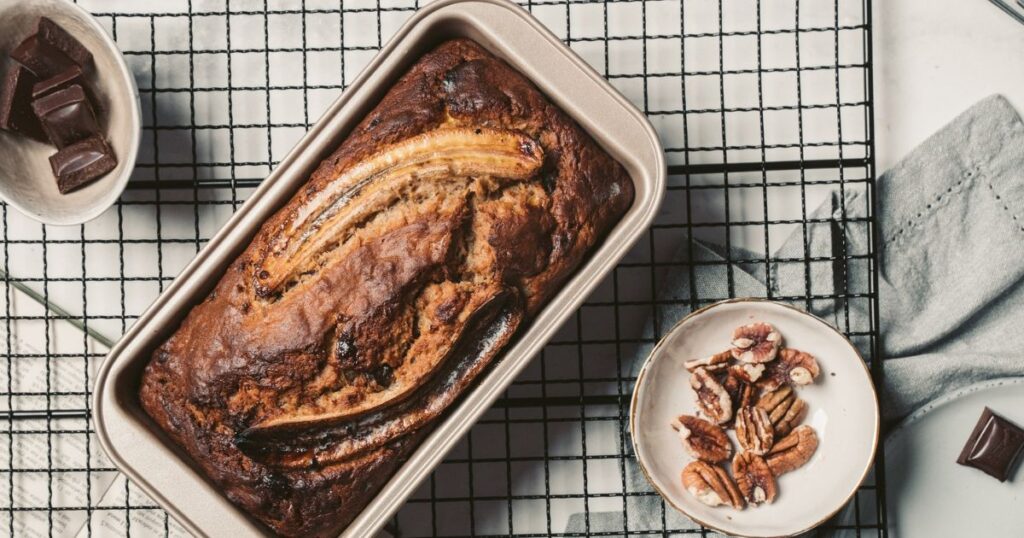
1 Comment
Pingback: Easy Peanut Butter Banana Cookies | Only 4 Ingredients